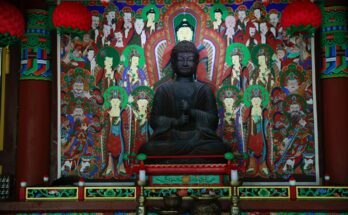Psychoanalysis and Buddhism: Blending of Science and Religion
The self as understood in Buddhism and the psychoanalysis approaches employed to address it is not only analytically understandable, but some advantages of psychoanalytic practice may also become apparent by examining the parallels and divergences between the two traditions.
Because psychoanalysis and Buddhism borrows from each other we should dwell to explore their relationship. In this article we have covered various vantage point to discuss how they both relate to each other. Because the issue demands a scientific outlook you will also find references to people who have worked in this field.
Modern understanding: Psychoanalysis and Buddhism
Image Credits: Unsplash.com
The Buddhist tradition provides a cleverly straightforward description of the human psyche that can greatly contribute to our current understanding of them. A large portion of Buddhist psychology is based on the three-way relationship between organs, objects, and moments of knowing. This relationship illustrates the essential connection of consciousness with its material components. The Buddha also emphasized the need of systematic awareness training of body sensations as a means of improving the mind-body connection. The material form, consciousness, feeling, perception, and emotional states are the five parts or functions of the mind.
According to the Buddhist perspective, delusions of selfhood, stability, and satisfaction are false beliefs that result from misperception and misthinking. When Buddhists list greed, hatred, and delusion as the three basic or core emotions that are bad, they sound a lot like Sigmund Freud.
Mindfulness: Psychoanalysis and Buddhism
Buddha gained notoriety for promoting mindfulness, which is still a little-known method of moment-to-moment awareness meditation. In the past, reformers like D. W. Winnicott and Buddha were raised outside of established orthodoxies and later reinterpreted them in light of their own intensely personal experiences. As he worked out his concepts, Winnicott unintentionally created the framework for a psychoanalytic interpretation of Buddhist philosophy.
In the early Buddhist teachings, child-parent themes are mostly absent, even though it is stated that the Buddha’s mother passed away when he was only a week old. According to Buddhist theory, the joy of the kids at the beach represents the orgasmic happiness of the enlightened mind.
What does Dr. Epstein say?
Image Credits: Unsplash.com
In his analysis of the work of prominent and highly influential British psychotherapist Donald W. Winnicott, MD, Dr. Epstein provides shockingly fresh findings. He elucidates Winnicott’s hitherto overlooked connection to Buddhism. In his description, the children’s play area by the water represents the change from the sea to the land, together with all of its symbolic meanings.
He eloquently summarizes Sigmund Freud’s incapacity to personally encounter Romain Rolland’s “oceanic experience” and draws parallels between Freud’s contemplation of the ego’s link to the unconscious and the Buddha’s investigation of the boundaries between the self and not-self. The notions of clinging, clutching, possessing, and holding on are relevant to both Buddhism and motherhood.
Concerning the mind
Buddhism benefits from psychoanalysis’s multifaceted road map of the sick mind’s worries, protective ideas and feelings, relational circumstances, and recurrent patterns. Psychoanalysis can benefit greatly from Buddhist meditation’s thorough training of optimal attention and deep phenomenological observation, which is potentially broader than the phenomena that psychoanalysis examines. Sigmund Freud promoted “evenly-suspended attention” when listening to his patients. Paying attention follows the patient’s words as they flow, emphasizing and omitting things.
The level of care that Bion recommended enables the therapist and the patient to understand the patient’s resisted chaos and suffering on an experienced level. Similar ideas were expressed by Donald W. Winnicott regarding the importance of paying attention to transitional space—a place where logic, time, right and wrong, relationships with one’s parents, mother, and father, as well as regular judgement, are suspended. There is a liberation from identity and dualism, from self-consciousness and consequence.
Use of words: Psychoanalysis and Buddhism
Image Credits: Unsplash.com
There is a disagreement between psychoanalysis and Buddhism on language use. From the Buddhist perspective, a fundamental limitation of all talking therapies is that language is necessary for it to be generated and comprehended. Plotting emotions over an ethical scale is essentially what Buddhism is all about. The main focus being on how much emotions manifest along a continuum of healthy and ill.
Power of transference
Psychoanalysis can make a significant contribution to Buddhism in terms of its comprehension of transference and counter-transference. Spiritual traditions could undervalue these phenomena’ potency and the tenacity of human nature. Negative outcomes could occur if the instructor unintentionally connects with the transference’s powers.
According to Young-Eisendrath, Buddhism ought to, in theory, end this kind of suffering. Nevertheless, this might not occur, depending on the nature of the relationship between the student and the teacher. As well as the student’s engagement and practicing dedication.
Carl Jung: Psychoanalysis and Buddhism
A key player in the discussion between psychology and religion is Carl Jung. He talks on the mystical aspects of Buddhism, Taoism, Hinduism, and Christianity. Similar to William James, he believed that religion was a psychological truth.
Jung’s central idea for achieving spiritual and human development is individuation. The ultimate aim is unus mundus. It means a mystical condition resembling certain stages of meditation in which consciousness and unconsciousness are united. We must set aside our differences and allow the archetypes of God or the unity of Self to lead us to wholeness.
Meditation and Buddhism

IMAGE CREDITS: Pexels.com
Being mindful In these integrations, meditation is essential. It entails remembering what is happening while it is happening and raising awareness of and participation in the current moment. It aligns with some analysts’ shift from a “there and then” emphasis. That is how previous traumas affect the present to a “here and now” emphasis on the therapist-client relationship and meaning-making. Beyond expression and suppression, it provides a third path rather than a transcendent absorption condition.







